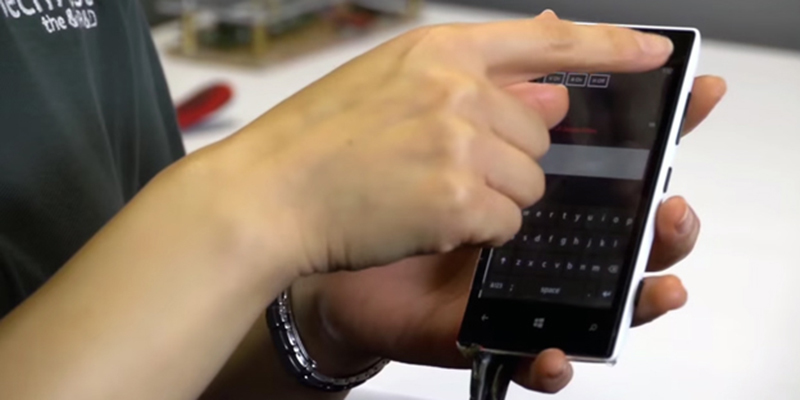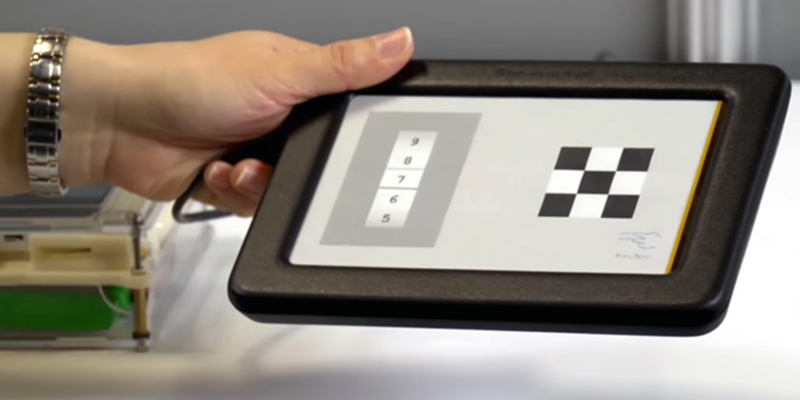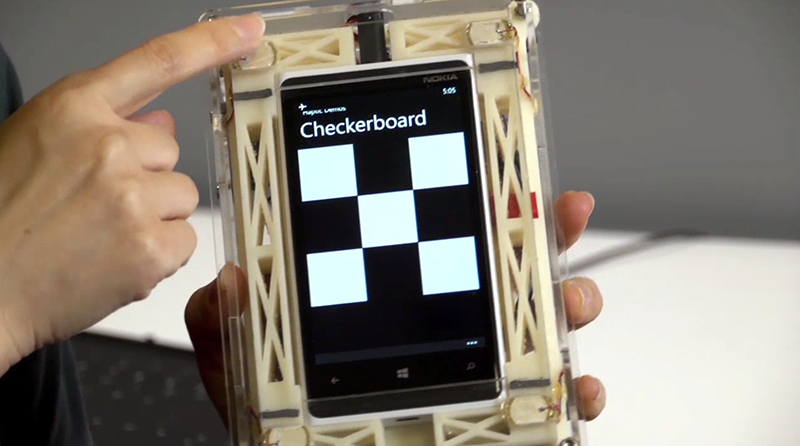Hand-in-hand: tactile feedback displays become reality
A touch screen is the head for everything when it comes to modern mobile devices. Many users have long been accustomed to almost unrequited relationships with them - the maximum that is available today is the easy twitching of vibration motors that record the fact of interaction with the interface.

Fortunately, there are people in the world who have set their goal to change the situation. These are a group of researchers from Microsoft Research , led by Hong Tan, who for several years have been closely involved in the development of feedback displays. They have already introduced several valid prototypes, including those based on Nokia Lumia.
In the days of push-button phones, users did not have much trouble fixing the response from the device. Mechanical keyboards even allowed blind typing - a skill so common among young people in the early 2000s and now available only to the most notorious mobile ninja.
However, Microsoft researcher Ms. Hong Tan, specializing in tactile feedback developments, that touch screens must evolve, taking into account all the experience of past years.

“What can be considered a really cool achievement is to take a smooth piece of glass and make it something special,” says Ms. Tan. “It's almost magic.”
Currently, Hong is working to give tactile feedback to touchscreens. Moreover, this should be understood not only as a response to pressing virtual keys, but also as a sensation of various textures of graphic elements.
The most amazing thing is that devices with similar screens already exist not only in theory - ready-made prototypes can be examined in detail in the following video:
As we said at the beginning of our post, some devices can respond to touch vibration feedback, using the entire body. This is a good simulation, but still it is far from ideal. Another thing is when the device interacts with the user exactly at the point of “working” touch. Despite the fact that the feedback technologies of touch displays are still in the process of research and are not ready for implementation in mass production, functioning prototypes (built including those based on Lumia smartphones) suggest that the user experience may change again in the future.
“We are developing technologies that will allow you not only to touch the computer screen, but also to feel it,” says Ms. Hong Tan.
Now a group of developers from Microsoft Research is closely engaged in research on the implementation of tactile feedback in devices with touch displays, which include work on both hardware and software. From the point of view of human perception, some of them are based on stimulation of skin receptors, while others are based on muscle receptors.

One option is to use a piezoelectric material in the interlayer between the protective glass and the display. Under the influence of electric voltage, the active layer bends, and after it the outer layer also bends a little. Even the slightest change in the physical structure of the surface at the point of contact (the glass of the smartphone and the user's finger) gives the sensation of a key being pressed, and the characteristic click that occurs with the above action only enhances this sensation.
“When you type on the virtual keyboard of a smartphone, the outer layer literally instantly bends under your fingers. This is a very small deflection, but it is enough for your fingers to receive a signal reminding you to press a button, ”Ms. Hong says.
Another option is to use an electrostatic field to create an air gap between the display and the user's fingers. In addition, a variant in which high-frequency vibration will be involved is possible.
In each of the specific cases (and in studies of the tactile feedback of touch displays in general), the work is interdisciplinary. So, for example, in the case of vibration feedback, researchers need not only to be experts in electronics and mechanics, but also have extensive knowledge about human sensitivity to various vibration frequencies.
In addition, the above mechanics (or combinations thereof) can make certain parts of the screen roughened or smooth, as shown on the black and white checkerboard on the Lumia 920. This principle can be used, for example, to simulate the texture of sand or metal in an image.

Even as of the current moment, this technology seems very interesting and promising. In the case of its commercial implementation, it is not only able to simplify the process of user interaction with a smartphone, but also make life easier for people with disabilities.

Fortunately, there are people in the world who have set their goal to change the situation. These are a group of researchers from Microsoft Research , led by Hong Tan, who for several years have been closely involved in the development of feedback displays. They have already introduced several valid prototypes, including those based on Nokia Lumia.
In the days of push-button phones, users did not have much trouble fixing the response from the device. Mechanical keyboards even allowed blind typing - a skill so common among young people in the early 2000s and now available only to the most notorious mobile ninja.
However, Microsoft researcher Ms. Hong Tan, specializing in tactile feedback developments, that touch screens must evolve, taking into account all the experience of past years.

“What can be considered a really cool achievement is to take a smooth piece of glass and make it something special,” says Ms. Tan. “It's almost magic.”
Currently, Hong is working to give tactile feedback to touchscreens. Moreover, this should be understood not only as a response to pressing virtual keys, but also as a sensation of various textures of graphic elements.
The most amazing thing is that devices with similar screens already exist not only in theory - ready-made prototypes can be examined in detail in the following video:
As we said at the beginning of our post, some devices can respond to touch vibration feedback, using the entire body. This is a good simulation, but still it is far from ideal. Another thing is when the device interacts with the user exactly at the point of “working” touch. Despite the fact that the feedback technologies of touch displays are still in the process of research and are not ready for implementation in mass production, functioning prototypes (built including those based on Lumia smartphones) suggest that the user experience may change again in the future.
“We are developing technologies that will allow you not only to touch the computer screen, but also to feel it,” says Ms. Hong Tan.
Now a group of developers from Microsoft Research is closely engaged in research on the implementation of tactile feedback in devices with touch displays, which include work on both hardware and software. From the point of view of human perception, some of them are based on stimulation of skin receptors, while others are based on muscle receptors.

One option is to use a piezoelectric material in the interlayer between the protective glass and the display. Under the influence of electric voltage, the active layer bends, and after it the outer layer also bends a little. Even the slightest change in the physical structure of the surface at the point of contact (the glass of the smartphone and the user's finger) gives the sensation of a key being pressed, and the characteristic click that occurs with the above action only enhances this sensation.
“When you type on the virtual keyboard of a smartphone, the outer layer literally instantly bends under your fingers. This is a very small deflection, but it is enough for your fingers to receive a signal reminding you to press a button, ”Ms. Hong says.
Another option is to use an electrostatic field to create an air gap between the display and the user's fingers. In addition, a variant in which high-frequency vibration will be involved is possible.
In each of the specific cases (and in studies of the tactile feedback of touch displays in general), the work is interdisciplinary. So, for example, in the case of vibration feedback, researchers need not only to be experts in electronics and mechanics, but also have extensive knowledge about human sensitivity to various vibration frequencies.
In addition, the above mechanics (or combinations thereof) can make certain parts of the screen roughened or smooth, as shown on the black and white checkerboard on the Lumia 920. This principle can be used, for example, to simulate the texture of sand or metal in an image.

Even as of the current moment, this technology seems very interesting and promising. In the case of its commercial implementation, it is not only able to simplify the process of user interaction with a smartphone, but also make life easier for people with disabilities.
